Punjab is aptly referred to as the “Land of Five Rivers,” a name derived from the Persian words “Panj,” meaning five, and “Ab,” meaning river, reflecting the abundant waterways that traverse its fertile plains. The essence of Punjab’s namesake is embodied by its five majestic rivers: Jhelum, Sutlej, Ravi, Beas, and Chenab. Known for its fertile lands, incredible cuisine, and the iconic Golden Temple, Punjab is a destination that captures the hearts of travelers seeking authentic Indian experiences. Whether you’re a history buff, a foodie, or an adventurer, Punjab offers a tapestry of attractions that enthrall you. In this blog post, we’ll embark on a journey exploring the must-visit places in Punjab, offering insights and tips to make your adventure unforgettable.
Places to Visit in Punjab
1. Amritsar – The Spiritual and Cultural Heartbeat
A. The Golden Temple (Sri Harmandir Sahib)
This is one of the most famous places to visit in Punjab, be ready to be a part of the First Hukamnama in the Golden Temple at 5:00 AM. One of the world’s most revered Sikh shrines, the Golden Temple exudes an aura of tranquility and spirituality. Its shimmering golden structure, surrounded by the Amrit Sarovar (Pool of Nectar), creates a breathtaking sight. Take a parikrama (walkway) around the temple, soak in the peaceful atmosphere, and enjoy the soulful kirtan (devotional hymns). Don’t miss visiting the Central Sikh Museum to learn about Sikh history and witness rare artifacts.
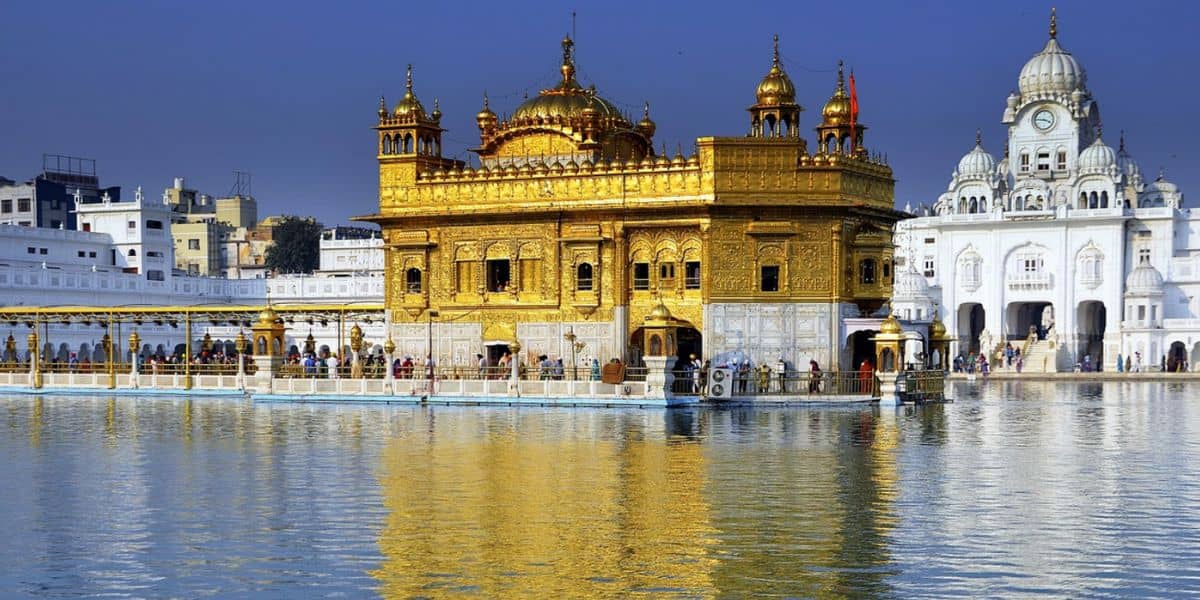
The architecture of the Golden Temple represents a beautiful blend of Hindu and Islamic styles. Maharaja Ranjit Singh, a powerful Sikh ruler, covered the upper floors of the temple with around 400 kg of gold leaf in the early 19th century, giving it the name “Golden Temple”. The temple stands on an island in the middle of the Amrit Sarovar (Pool of Nectar), a sacred body of water. The Golden Temple complex houses a massive community kitchen (Langar) serving free vegetarian meals to thousands of people daily, regardless of religion or social background. Situated within the precincts of the Golden Temple complex, the Akal Takht (Throne of the Timeless One) stands as the paramount seat of temporal authority in Sikhism. In the evening time, it looks beautiful, If you have time you can visit in the evening so you can add a special moment in your life.
Facts About Golden Temple:
History and Construction
- Foundation: Founded in 1577 by the fourth Sikh Guru, Guru Ram Das.
- Adi Granth: The first installation of the sacred Sikh scripture, the Adi Granth (later the Guru Granth Sahib), took place in 1604 by the fifth Sikh Guru, Guru Arjan Dev.
- Philosophy of Openness: The temple has four entrances facing each cardinal direction, symbolizing its openness to people of all backgrounds and faiths.
- Wars and Reconstruction: The Golden Temple has been destroyed and rebuilt several times throughout its history, most notably during the 18th-century Afghan invasions.
Spiritual Significance
- Holiest Sikh Shrine: The Golden Temple is the holiest Gurdwara (Sikh place of worship) and holds immense spiritual importance for Sikhs around the world.
- Symbol of Equality: It symbolizes the principles of human brotherhood and equality in Sikhism.
Other Interesting Facts
- Langar (Community Kitchen): The Golden Temple runs one of the world’s largest free kitchens, serving up to 100,000 meals daily to people from all walks of life.
- Hall’s surface is cleaned daily with a mixture of milk and water.
- They believe in not wasting food and always request that people take only that much food they can eat.
- Equality and Service: The concepts of equality and selfless service (seva) are central to the philosophy practiced at the Golden Temple.
- Har Ki Pauri: Positioned at the rear of the primary temple, this sacred spot allows pilgrims to descend the stairs and reverently partake in the tradition of receiving a handful of Amrit (nectar) from the Harmandir Sahib Sarovar.
Before Going to Temple you should Know:
- Please ensure to cover your head with a scarf.
- Proceed by walking clockwise around the pool and temple.
- Please deposit your shoes and luggage at the security checkpoint.
- Before entering the temple, kindly wash your feet.
- Kindly ensure to switch off your mobile phone before entering.
- Photography is permitted solely within the outer periphery.
- Swimming is strictly forbidden within the premises.
Visit Timings: 03:00 AM – 10:00 PM
Entry Fee: NA
Location: Atta Mandi, Katra Ahluwalia, Amritsar, Punjab.
Trip Duration: 2 – 3 Hour
Best Time to Visit: From February to March & September to December
B. Jallianwala Bagh: A Historic Landmark of Remembrance
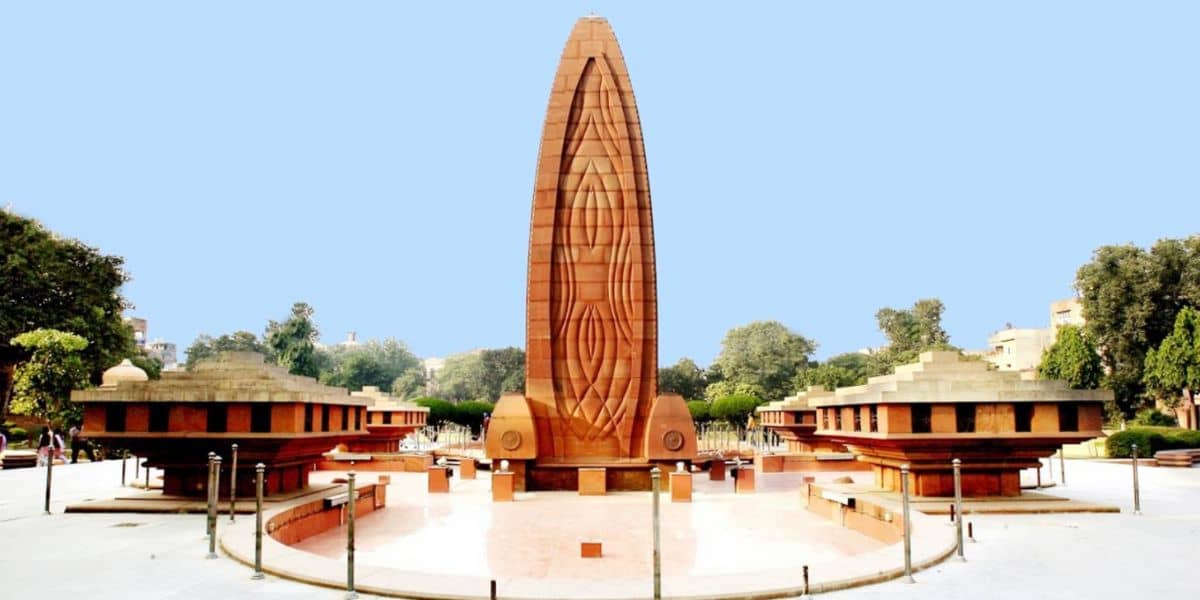 A poignant reminder of India’s struggle for independence, Jallianwala Bagh is a memorial garden marking the site of a tragic massacre in 1919. Pay your respects at the memorial, see the preserved bullet holes in the walls, and reflect in the peaceful gardens. Spend some time seeing this garden and feel the situation that was happened.
A poignant reminder of India’s struggle for independence, Jallianwala Bagh is a memorial garden marking the site of a tragic massacre in 1919. Pay your respects at the memorial, see the preserved bullet holes in the walls, and reflect in the peaceful gardens. Spend some time seeing this garden and feel the situation that was happened.
- Historical Significance: This park serves as a somber memorial to the estimated 1,500 individuals who tragically lost their lives or sustained injuries during the 1919 Jallianwala Bagh Massacre. British forces opened fire on a peaceful assembly of protesters advocating for the release of arrested Indian Independence Movement leaders.
- Evidence of the Massacre: Visitors can still observe bullet holes etched into the garden walls, a chilling testament to the violence.
- Martyrs’ Gallery: The memorial site houses the Martyrs’ Gallery, paying tribute to pivotal figures who fought for Indian independence.
- Eternal Flame & Presentation: Witness a poignant presentation honoring the victims and see a symbolic eternal flame burning in their memory.
Interesting Facts about Jallianwala Bagh:
- The site is infamous for the Jallianwala Bagh massacre, which occurred on April 13, 1919.
- During the massacre, British Indian Army troops under the command of Brigadier General Reginald Dyer fired on a crowd of unarmed Indian civilians who had gathered for a peaceful protest against oppressive British policies.
- Estimates vary, but it is believed that hundreds of innocent men, women, and children were killed, and thousands were injured in the indiscriminate firing.
- The incident is considered one of the darkest chapters in India’s struggle for independence from British colonial rule.
- The Jallianwala Bagh memorial, established in 1951, commemorates the victims of the massacre.
- The memorial features a preserved portion of the park, bullet marks on the walls, and a memorial plaque.
- Jallianwala Bagh remains a symbol of India’s fight for freedom and serves as a reminder of the sacrifices made by those who struggled against colonial oppression.
Visit Timings: 06:30 AM – 07:30 PM
Entry Fee: NA
Location: Amritsar, Punjab.
Trip Duration: 1 – 2 Hour
Best Time to Visit: From February to March & September to December
C. Wagah Border Ceremony
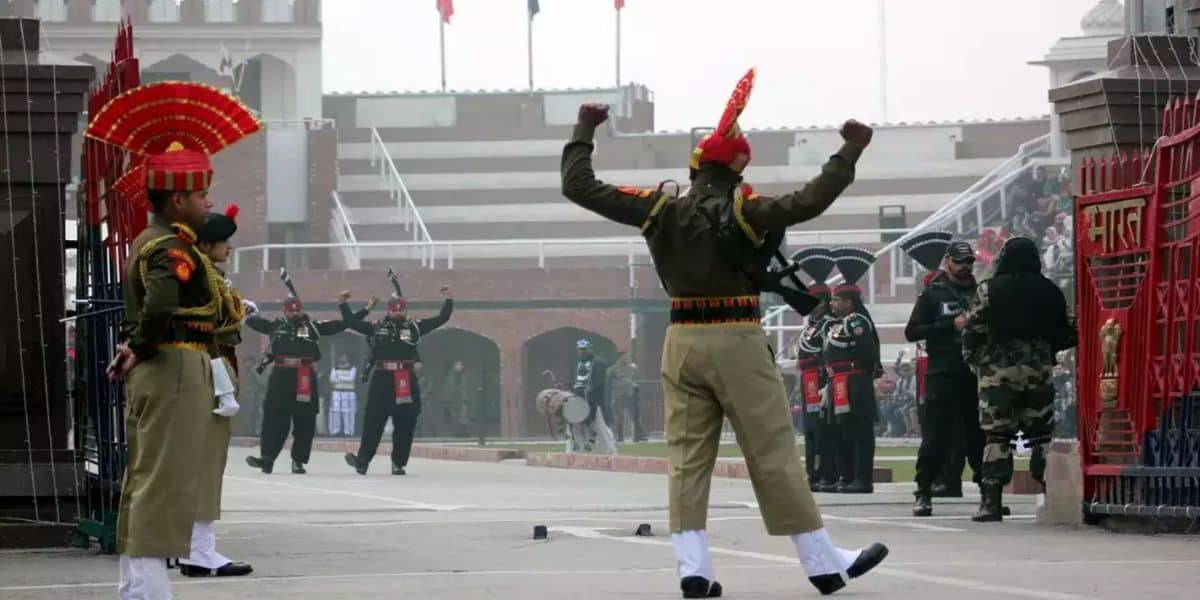 Experience the unique energy of the daily Wagah Border Ceremony, where Indian and Pakistani soldiers perform a highly stylized and choreographed flag-lowering ceremony. The patriotic fervor and showmanship on both sides are a sight to behold.
Experience the unique energy of the daily Wagah Border Ceremony, where Indian and Pakistani soldiers perform a highly stylized and choreographed flag-lowering ceremony. The patriotic fervor and showmanship on both sides are a sight to behold.
- History & Purpose: Officially, the Wagah Border Ceremony is a daily event to formally close the border between India and Pakistan at sunset and lower the national flags of both countries. However, it has evolved into a highly energetic and symbolic display of national pride.
- Location: The ceremony takes place at the Wagah-Attari border crossing, situated on the historic Grand Trunk Road, approximately 30 kilometers from Amritsar, India, and Lahore, Pakistan.
- Start Date: The tradition began in 1959.
- Rivalry & Camaraderie: The ceremony is often seen as a symbol of both the ongoing political rivalry between India and Pakistan and the desire for peaceful coexistence.
- The March: Soldiers from the Border Security Force (India) and Pakistan Rangers perform a synchronized and energetic march with synchronized steps, high kicks, and patriotic slogans.
- Flag Lowering: The ceremony culminates in the dramatic lowering of the Indian and Pakistani flags at sunset, creating a powerful visual display.
- Entertainment Value: The ceremony has become a major tourist attraction, drawing thousands of visitors from both countries and around the world. The atmosphere is electric, with cheering crowds, patriotic music, and a sense of spectacle.
- Soldier Selection & Training: Soldiers chosen to participate in the ceremony undergo rigorous training to perfect their synchronized movements and project a powerful image.
- Facial Hair Allowance: Interestingly, soldiers chosen for the ceremony are often given an allowance to grow a moustache and beard, considered a sign of masculinity and adding to the theatrics.
- Cancellation: The ceremony is rarely canceled, but on a few occasions, political tensions or security concerns have forced its postponement.
Visit Timings: 04:15 PM – 05:00 PM (Winter) & 05:15 PM – 06:00 PM (Summer).
Entry Fee: NA. Entry starts at around 2-3 PM so the recommendation is to reach some time before.
Location: Amritsar, Punjab.
Trip Duration: 4 – 5 Hour
Best Time to Visit: NA
D. Amritsari Cuisine
 Amritsar is legendary for its street food and rich Punjabi flavors. Indulge in buttery kulchas, spicy chole bhature, tandoori chicken, creamy maharaja lassi, and don’t forget the decadent Amritsari fish! The fish test is delicious and without this food is not complete.
Amritsar is legendary for its street food and rich Punjabi flavors. Indulge in buttery kulchas, spicy chole bhature, tandoori chicken, creamy maharaja lassi, and don’t forget the decadent Amritsari fish! The fish test is delicious and without this food is not complete.
2. Chandigarh – The Modern Marvel
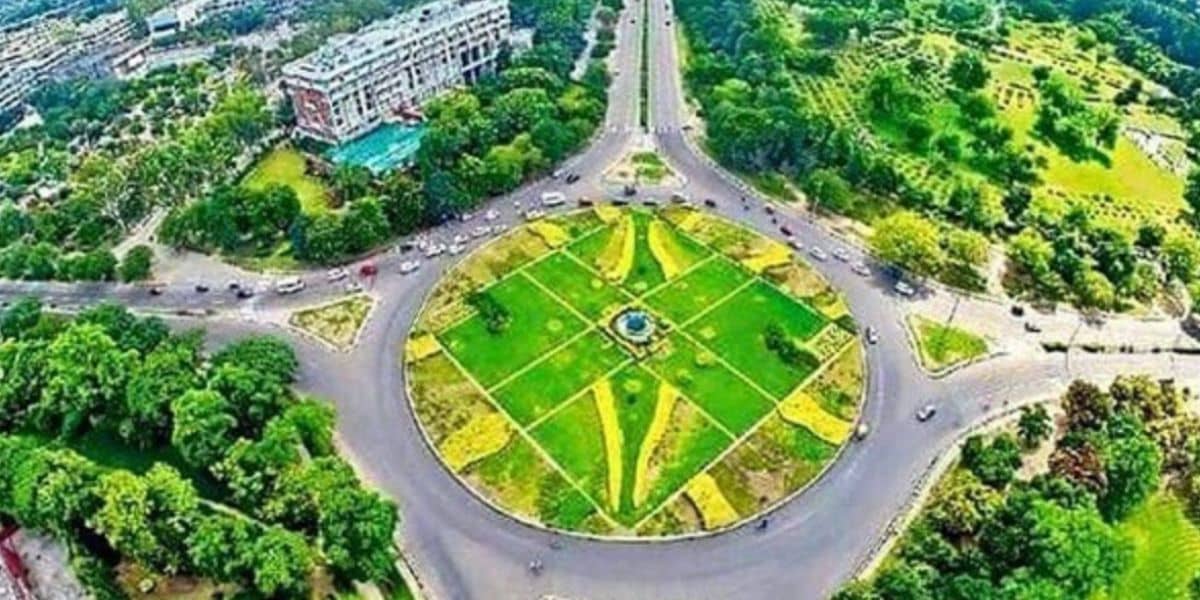 Chandigarh, the capital of Punjab and Haryana, stands out as a beacon of modern urban planning. Designed by the legendary architect Le Corbusier, the city boasts a unique grid-like layout, spacious boulevards, and striking modernist architecture.
Chandigarh, the capital of Punjab and Haryana, stands out as a beacon of modern urban planning. Designed by the legendary architect Le Corbusier, the city boasts a unique grid-like layout, spacious boulevards, and striking modernist architecture.
From the iconic Capitol Complex to the whimsical Rock Garden, Chandigarh offers a captivating blend of architectural marvels and natural beauty. Sukhna Lake provides a serene escape for boating and picnics, while the Zakir Hussain Rose Garden is a vibrant showcase of thousands of rose varieties.
Chandigarh’s organized structure, lush green spaces, and diverse cultural attractions make it a delightful and refreshing change of pace for travelers seeking an offbeat Indian destination.
A. Rock Garden: A Masterpiece of Recycled Art
Chandigarh’s Rock Garden is a marvel of creativity and sustainability, crafted entirely from recycled and discarded materials by artist Nek Chand. Wander through its whimsical paths, and marvel at the sculptures, waterfalls, and hidden pathways.
- Visionary Artist: Nek Chand Saini, a humble government worker, was the creative genius behind the Rock Garden.
- Hidden Masterpiece: Nek Chand worked in secret for 18 years, building the garden in a hidden gorge.
- Recycled Wonderland: The entire garden is constructed from discarded materials like broken bangles, ceramic, tiles, industrial waste, and other found objects.
- 40-Acre Fantasy: The Rock Garden now covers a sprawling 40 acres of whimsical creations.
- Mosaics and Sculptures: Explore intricate mosaics, and fantastical sculptures of dancers, animals, and mythical figures.
- Waterfalls and Courtyards: Meander past man-made waterfalls and captivating courtyards.
- Themed Kingdom: Discover a themed section depicting a royal kingdom, complete with a court, musicians, and subjects.
- Sustainability Icon: The Rock Garden is a powerful symbol of upcycling and sustainable art.
B. Sukhna Lake: Chandigarh’s Waterfront Haven
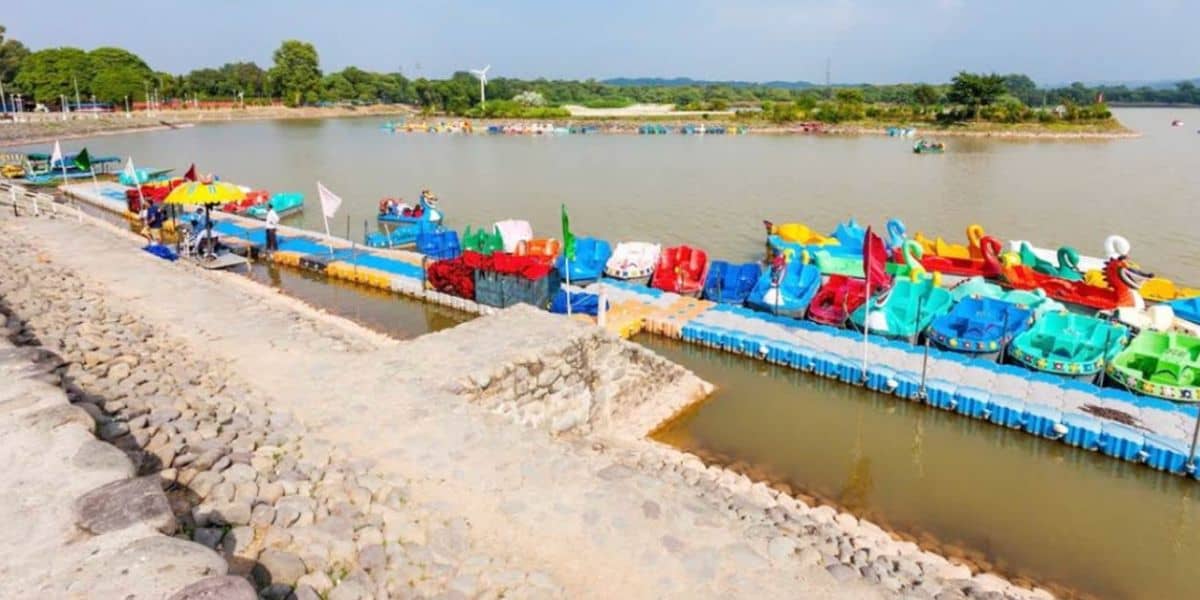 Enjoy a scenic boat ride on Sukhna Lake or stroll along its promenade admiring the beautiful sunsets. This artificial lake provides a peaceful respite from the city’s bustle.
Enjoy a scenic boat ride on Sukhna Lake or stroll along its promenade admiring the beautiful sunsets. This artificial lake provides a peaceful respite from the city’s bustle.
Things to Do at Sukhna Lake
- Leisurely Walks and Jogs: Highlight the scenic lakefront pathways perfect for walking, jogging, and enjoying the views.
- Boating: Mention the variety of boating options available: paddle boats, shikaras (traditional boats), etc.
- Birdwatching: Emphasize the lake as a bird-lovers paradise, with a variety of resident and migratory birds.
- Food and Refreshments: Talk about the food stalls and cafes lining the lake, offering snacks and drinks.
- Sunset Spot: Describe the breathtaking sunsets over the lake and how it becomes a popular gathering spot in the evenings.
C. Capitol Complex: A UNESCO World Heritage Site
 Designed by renowned architect Le Corbusier, the Capitol Complex comprises the iconic buildings of the Punjab and Haryana High Court, Legislative Assembly, and Secretariat. It’s a testament to Chandigarh’s modernist vision. Introduce the Capitol Complex as a monumental architectural masterpiece designed by Le Corbusier.
Designed by renowned architect Le Corbusier, the Capitol Complex comprises the iconic buildings of the Punjab and Haryana High Court, Legislative Assembly, and Secretariat. It’s a testament to Chandigarh’s modernist vision. Introduce the Capitol Complex as a monumental architectural masterpiece designed by Le Corbusier.
-
Key Buildings
- Palace of Assembly: The legislative heart of the complex.
- Secretariat Building: The administrative hub, notable for its long concrete facade.
- High Court: A symbol of justice, with its iconic parasol roof.
-
Architectural Significance
- Modernist Vision: Describe the Capitol Complex as an embodiment of Le Corbusier’s modernist principles and his vision for a planned city.
- Brutalism: Discuss the complex’s use of raw concrete and bold geometric forms, exemplifying the Brutalist style.
- Open Hand Monument: Explain the symbolism of this giant sculpture and its significance to Chandigarh.
-
Things to See and Do
- Guided Tours: Recommend joining a guided tour for in-depth information about the architecture and history.
- Photography: Emphasize the photogenic nature of the buildings and their surroundings.
- Geometric Garden and Tower of Shadows: Briefly mention these additional structures within the complex.
D. Zakir Hussain Rose Garden: Chandigarh’s Floral Paradise
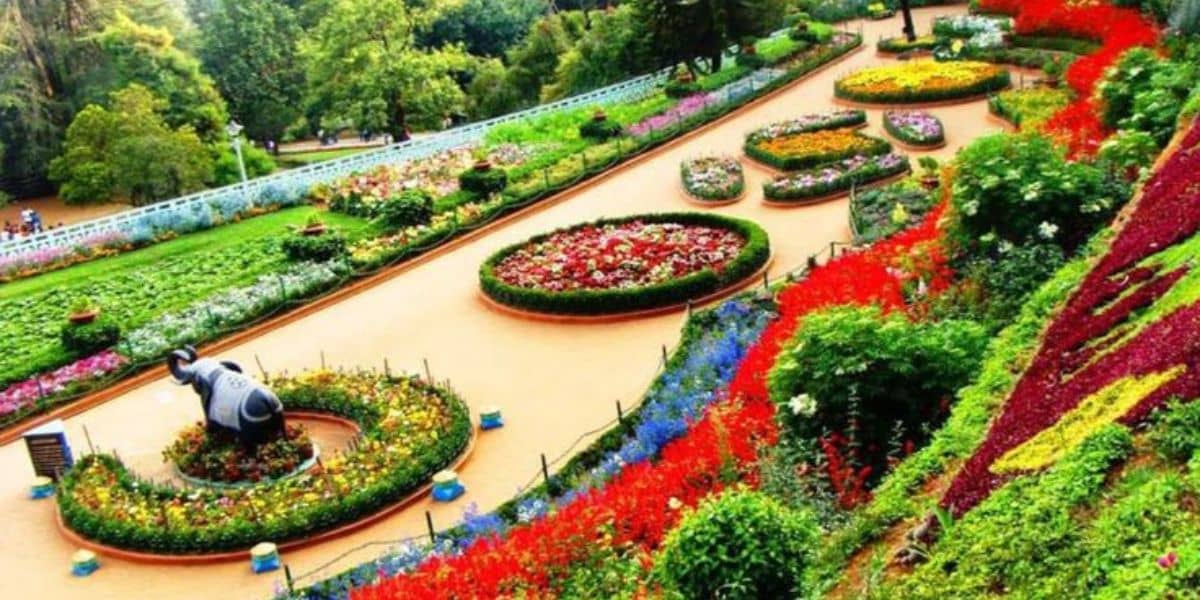 Asia’s largest rose garden is a feast for the senses. Explore different varieties of roses, enjoy the fragrance, and relax amidst its manicured lawns.
Asia’s largest rose garden is a feast for the senses. Explore different varieties of roses, enjoy the fragrance, and relax amidst its manicured lawns.
-
A Riot of Roses
- 50,000 rose bushes: Highlight the immense scale of the garden.
- 1,600+ varieties: Emphasize the incredible diversity of roses on display.
- Blooming seasons: Mention the best times to visit for peak blooms (Feb-Mar and later in the year).
-
Beyond Roses
- Medicinal plants: Touch upon the section dedicated to medicinal plants and their uses.
- Beautiful landscaping: Describe the manicured lawns, pathways, and fountains adding to the garden’s charm.
-
Things to Do
- Leisurely strolls: Emphasize the garden as a perfect place for a relaxed walk amidst the flowers.
- Photography: Highlight the abundance of photo opportunities among the colorful blooms.
- Annual Rose Festival: Mention the vibrant festival held each year, showcasing rose displays, competitions, and cultural events.
-
Tips for Visiting
- Best Timing: Suggest early mornings or late afternoons for the most pleasant experience.
- Comfortable footwear: Recommend comfortable shoes for exploring the sprawling garden.
- Picnic potential: Mention that the garden is a lovely spot for a picnic (if allowed).
-
Location and Entry
- Provide information on the garden’s location within Chandigarh.
- Note the entry fees, if applicable.
Other Places to visit in Chandigarh
Butterfly Park
Morni Hills
Shanti Kunj
Yadvinder Garden
Sarkaria Cactus Garden
Chhatbir Zoo
Timber Trail
Government Museum and Art Gallery
Chandigarh Botanical Garden
Read Also: Places to visit in Nepal
FQAs:
Question: Which is the most beautiful city in Punjab?
Answer. Yet, Amritsar frequently garners acclaim as one of the most picturesque cities owing to its serene ambiance, where the renowned Golden Temple and adjacent attractions allure all who visit.